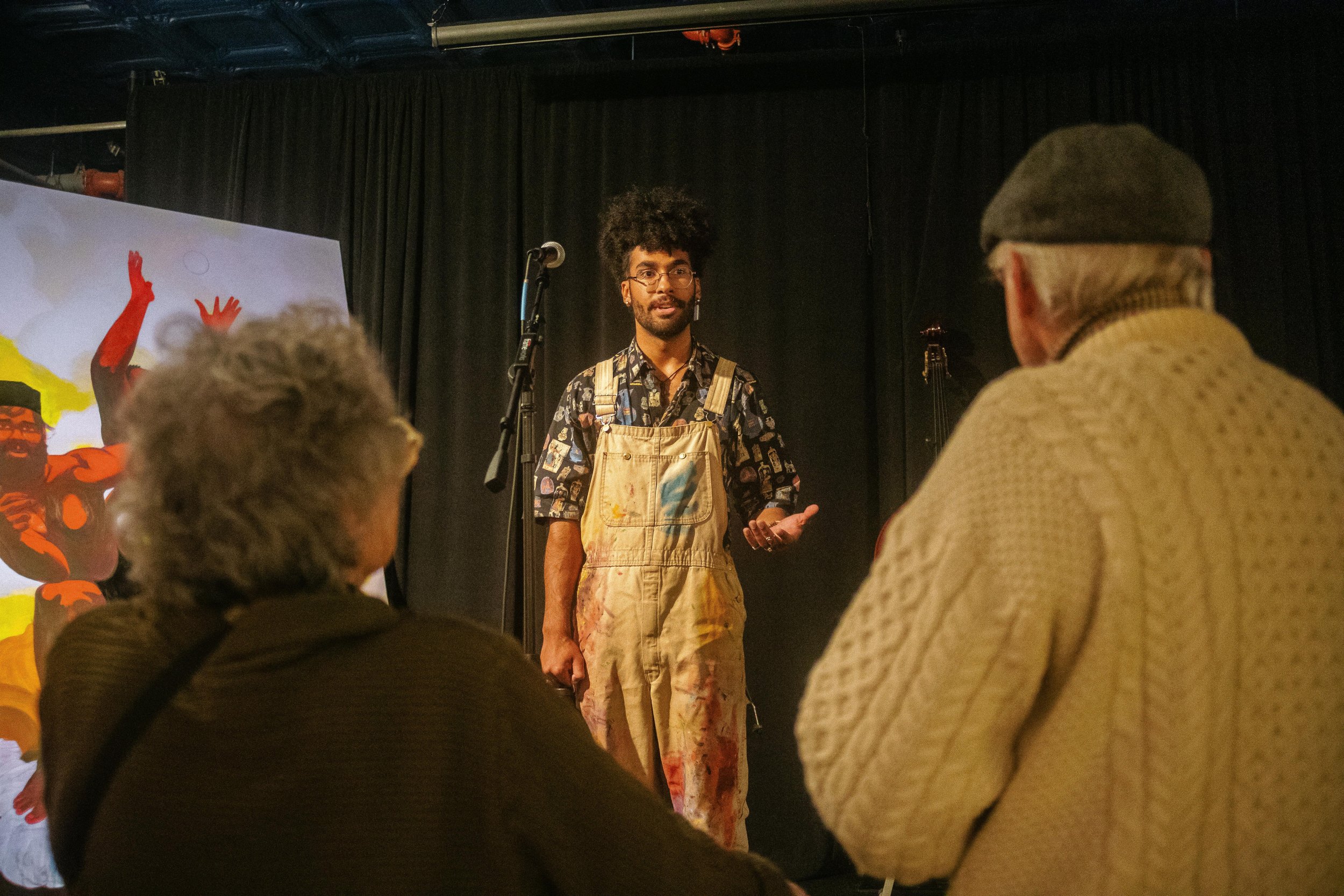
Reparations in Residence
A spatial justice initiative.
Venues have space, Artists need it. Let’s work it out.
The Reparations in Residence (RiR) initiative creates opportunities for cross-sector collaboration, community building, and a commitment to spatial justice that goes beyond land acknowledgments and DEI statements.
What if the last concert venue you entered was the site of an installation by a Nipmuc artist in residence? What if the next gallery you visit had a Black American musician in residence, responding to the artwork on the white walls? Recognizing that public and privatized American spaces are sites of European colonial violence and systemic racism, what can you do to platform the Black and Indigenous peoples who are here now?
“By using public space, the self becomes aware of questions of power. How comfortable am I in this space? How welcome or unwelcome am I here? If working in a group, the self becomes aware of these questions in relation to the temporary community of that group. How comfortable are we, here? Are we welcome? Would we be welcome or perceived as a threat if we were differently constituted (race, gender, age group, etc.)? Spatial practices encourage or challenge one’s own embodiment of the issues.”
- Jane Trowell
The Story
In developing Mirror, Mirror, my touring exhibit, and exploring how it can best engage the communities it touches, the residency format clicked with me. Living in Western Mass my whole life, I’ve observed a wealth of space and resources: empty studios, lonely machinery, stale walls in our many mill buildings, and lifeless barns. I’ve been fortunate to come across a couple programs like CitySpace’s Pay It Forward and the 50 Arrow Gallery’s annual Performance Art Residency, offering artists a space to work in addition to a stipend and some administrative support, and these programs lead by example: investing in equity by prioritizing BIPoC artists. However, most spaces fail to do so, and fail to forge supportive relationships with Black and Indigenous people. I conceived of Reparations in Residence as a way to bring artists and space managers together to address this problem creatively.
The Format
Reparations in Residence (RiR) is a flexible concept, meant to adapt to each artist, each space, and each space-steward for a uniquely beneficial opportunity, but it has constants.
Space: The steward must provide the resident a free space to reside for at least six weeks. (This space could be for working and/or living.)
Access must be 24/7, or at least 12/7, as an expression of trust/investment in the resident's work and autonomy, but the weeks do not need to be consecutive.
A longer period of time indicates a greater dedication to cultivating a restorative relationship.
Stipend: Especially if the steward is not already paying a land tax, they must arrange a stipend/honorarium for the resident.
Engagement: Hold an artist talk, consult the resident on a project that affects them, or otherwise foster a relationship between the resident, steward, and other patrons throughout the residency.
A resident painter might hold a conversation with the steward, create a painting that addresses a site-specific issue of inequity, and auction this painting to raise awareness and funds.
A resident poet might hold an open mic for Black and Indigenous patrons to share their local cultural experiences.
A steward might negotiate with the resident to commission a custom installation to help decolonize the space, temporarily or to remain after the residency.
The Intentions
Return Indigenous people to their ancestral lands · Replace performative activism · Disrupt colonial practices of ownership and erasure · Expand mutual aid initiatives · Initiate new partnerships · Uplift Black and Indigenous voices · Make spaces more inviting to Black and Indigenous people · Reallocate wealth equitably · Provide free studio space and resources to marginalized artists · Dismantle white supremacy · Develop site-specific spatial justice practices · Drive action for system change
“For non-Dakota people, you can begin to help us when you come to terms with your own role as oppressor. Although you cannot gift us our freedom from oppression, as only we can do that for ourselves, you can help to educate those around you and assist us in overturning colonial systems and institutions.”
- Dr. Waziyatawin Angela Wilson
You can have a hand in justice.
Let’s put reparations in residence.
References
Trowell, Jane. Wilson, Waziyatawin Angela. Interview by Critical Spatial Practice Reading Group. What Makes Justice Spatial? What Makes Spaces Just? Three Interviews on the Concept of Spatial Justice. Summer 2007, academia.edu/71225857/What_Makes_Justice_Spatial_What_Makes_Spaces_Just_Three_Interviews_on_the_Concept_of_Spatial_Justice_Critical_Spatial_Practice_Reading_Group. Accessed June 9 2025.
Wilson, Waziyatawin Angela. 2006. “Manipi Hena Owas’in Wicunkiksuyapi [We Remember All Those Who Walked].” In the Footsteps of Our Ancestors: The Dakota Commemorative Marches of the 21st Century. St. Paul, MN: Living Justice Press.
Szeto, Kim. Wong Camhi, Jessica. “Public Art for Spatial Justice.” New England Foundation for the Arts. 2024, nefa.org/CreateSpatialJustice. Accessed June 9 2025.
“Beyond Land Acknowledgment: A Guide.” Native Governance Center. 24 Oct. 2024, nativegov.org/resources/beyond-land-acknowledgment-a-guide/
This guide was developed after an event hosted in 2021 with a panel of speakers: Nikki Pitre (Center for Native American Youth), Joye Braun (Indigenous Environmental Network), President Robert Larsen (Lower Sioux Community), and Michelle Vassel and David Cobb (Wiyot Honor Tax).
Accessed June 9 2025.

